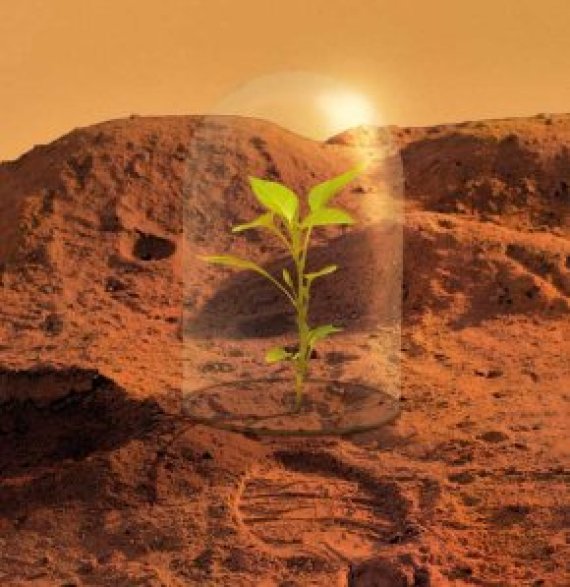He is not itching to go to Mars himself, says Wieger Wamelink. Certainly not as long as you can only get a one-way ticket. But the Dutch Mars One project, which aims to put the first people on Mars in 10 years’ time, did give him an idea. Those pioneers will need to eat. And you can’t take all the food you’re going to need with you. So might it be possible to grow terrestrial food on Martian soil? The answer is simple: we don’t know. Funnily enough, it is not something that has ever been researched. Not yet, that is. Last week Wieger Wamelink and Joep Frissel filled hundreds of pots with Martian soil ordered online and seeds of 14 different plants, and placed them in the PRI (Plant Research International) greenhouses in the Binnenveld. The seeds include tomatoes as well as rye, carrots, nettles, lupine, clover, ryegrass and cress. A bit of everything, all of them plants thought to be suited to Martian soil. The soil used does not actually come from Mars, but from a volcanic area on Hawaii where the soil is almost identical to the samples brought from Mars by Viking lander 1. The only difference is that the terrestrial soil is a little more magnetic. Mars has a very small magnetic field. The experiment is quite simple: a question of sowing the seeds and waiting to see whether they germinate under terrestrial conditions. That would be quite something. Mars is not Earth (see side bars) and our vegetation is designed for our planet, so trying to grow them on alien soil could be asking for trouble. But Wamelink is optimistic. And his enthusiasm is infectious. ‘A Wageningen colleague emailed me to say he is going to order some of the soil too and study its hydrological characteristics.’ But the first ever Martian farmer is realistic too. There is no shortage of problems, such as the high aluminium oxide levels in Martian soil. Some of this will be absorbed by the plants, says Wamelink. ‘Will it inhibit germination? Will plants die? Will the tomatoes be inedible because of the aluminium?’ He does not know. ‘But finding that out will be a nice job for Rikilt.’
Biosphere
Life on Mars is a bit different to life on Earth. Take the atmosphere for a start. It is inadvisable to take a deep breath because it will be your last. The atmosphere on Mars is comparable to that on Earth about four billion years ago. In other words; lots of carbon dioxide (95%), with some nitrogen (3%), argon and traces of oxygen, methane and water. Future residents will therefore have to live in an artificial Earth atmosphere. Some experience has been obtained with this, the most famous experiment being the construction of Biosphere 2 in the American state of Arizona. This is a gigantic closed ecosystem including humans. Unfortunately the project failed because oxygen levels were not self-sustaining. But something can be done about that.
Gravity
Gravity on Mars is more than two and a half times weaker than it is on Earth. An adult man weighs a mere 30 kilos on Mars. The question is: what are the implications of this for plants? Does it make them grow faster or slower? ‘I expect plants grow taller,’ says Wamelink. ‘According to physiologists, in trees, the height to which the sap can flow is the limiting factor for growth. You can calculate that this means a tree cannot grow taller than 120 metres. With weaker gravity, that height will be greater. So I think plants will be taller on Mars.’
Long summers
A year on Earth lasts 365 days, but Mars takes 687 days to go around the sun. That is almost twice as long, making for much longer seasons. What effect does that have on plants? Not too much, thinks Wamelink. ‘The length of a day is much more important to a plant than the length of a season. If the season is twice as long, two harvests might be possible. You find that happening in southern countries too. The sunlight on Mars is less intense, says Wamelink, because of the planet’s greater distance from the sun. Will that slow the growth of plants? Hard to predict. Radiation is certainly problematic, though. Mars has no magnetic field so that ionizing radiation penetrates to the surface. You have to find a way of repelling that, which is technically possible.’
Water
Plants need water. You can take it with you from the earth, but that is an expensive way of doing it. A better option is to ‘delve’ for it on Mars. It is certain that there is water on Mars. As research from NASA’s Mars vehicle Curiosity is showing this right now. According to Wamelink, making the water available to plants is no more than a technicality.

